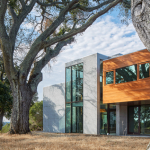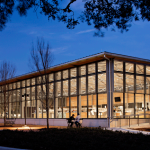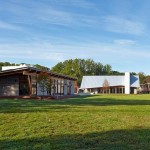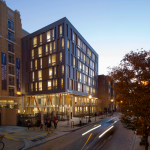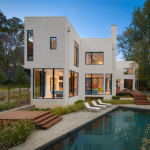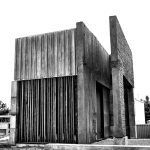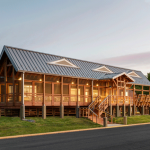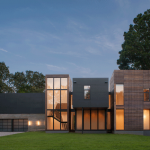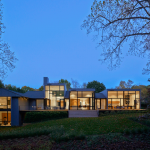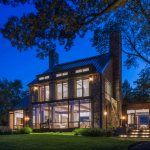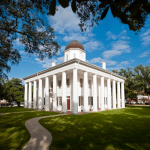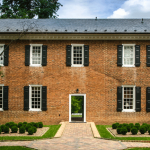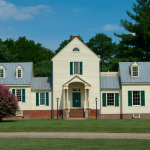
Virginia Architects are honoring the very best work by designers working in Virginia in the 2015 Awards for Excellence (also known as the Design Awards). These awards celebrate projects no older than seven years that contribute to the built environment and are clear examples of thoughtful and engaging design. This year juries have identified 8 Honor Awards, 13 Merit Awards and 8 Honorable Mention Awards. Award categories include Architecture, Contextual Design, Historic Preservation, Interior Design and Residential Design.
These projects will be on display at The Branch Museum of Architecture in Design in Design 2015: A Retrospective of Winning Work, Oct. 29, 2015–Jan. 3, 2016.
(image galleries follow each category announcement)
In the ARCHITECTURE category
The jury considers aesthetics, adherence to the client program, proven and projected building performance and concept development during its deliberations.
Architecture Honor Award Recipients:
- Woodside Residence (Woodside, Ca.) by David Jameson Architect, Inc.
“The richness of its materials and textures contributes significantly to the overall character,” says the jury. - East Servery (Houston, Tx.) by Hanbury Evans Wright Vlattas + Company
The jury stated, “This is a great ‘people space,’ beyond any expectations for an academic dining facility.”
Architecture Merit Award Recipients:
- Calcagnini Contemplative Center (Bluemont, Va.) by Dynerman Architects, PC
The jury commented, “The design for this spiritual retreat is carefully composed collection of buildings that creates a campus that is as charming in character as it is well organized.” - EAGLE ACADEMY Public Charter School at McGogney (Washington, D.C.) by Shinberg.Levinas Architects
The jury liked the “use of the polycarbonate material that allows the spaces to be filled with daylight but also turns the building into a glowing jewel at night.” - Research and Education Building (Wanchese, NC) by Clark Nexsen
“Not only do they achieve a LEED Gold rating, but they also demonstrate numerous innovative features that help protect the land, water and other natural resources,” commented the jury. - La Casa Permanent Supportive Housing (Washington, D.C.) by Studio Twenty Seven Architecture | Leo A Daly JV
The jury said, “The architecture presents a residential building full of life and hope and should be regarded as a positive example for the building type.” - 10th & G Street Offices and First Congregational United Church of Christ (Washington, D.C) by Cunningham | Quill Architects, PLLC
The jury noted, “The subtle distortions in the shape of the office tower as it floats above the base are effective in softening the building form in a varied urban context while also expanding diagonal views past the structure.”
Architecture Honorable Mention Recipients:
- The Shenandoah Valley Discovery Museum (Winchester, Va.) by Reader & Swartz Architects, P.C.
The jury commented, “The Discover Museum has reclaimed an existing structure and filled it with new life, energy … and fun!” - bm Modular One (Bethesda, Md.) by Robert M. Gurney, FAIA, Architect
“This house presents a well-executed advance in modular design,” said the jury. - The Cube (Blacksburg, Va.) by College of Architecture and Urban Studies, School of Architecture + Design, Virginia Polytechnic Institute and State University.
“This educational project is a very thoughtful exercise that reveals the possibilities and limitations of materials,” commented the jury.
In the CONTEXTUAL DESIGN category
The awards for contextual design are chosen based on outstanding architecture that perceptibly reflects the history, culture, and physical environment of the place in which it stands and that, in turn, contributes to the function, beauty, and meaning of its larger context.
Contextual Merit Award Recipients
- Citizen 6 (Richmond, Va.) by Burt Pinnock, Baskervill
“These townhouses successfully present a contemporary way to relate to a historical context while confidently adding another layer to the neighborhood history,” remarked the jury. - Seaside Hall, Virginia Institute of Marine Science (Wachapreague, Va.) by VIA Design Architects, P.C.
The jury commented, “The design for this highly contextual project is directly influenced by the vernacular traditions of wood-framed buildings that are typical in this seaside marshland region.”
Contextual Honorable Mention Recipients
- Chatham County Courthouse (Savannah, Ga.) by Dewberry Architects Inc.
“It is difficult to design a contemporary program that requires a building larger in scale than the historic neighborhood, but this project has made the historic neighborhood a priority and resulting design celebrates the context,” noted the jury.
In the RESIDENTIAL DESIGN category
Aesthetic appeal and functionality are two long-established criteria for home design as are affordability and resource efficiency. The jury looks at each submission in its totality toward meeting those goals.
Residential Design Honor Award Recipients:
- Riggins House (Cabin John, Md.) by Robert M. Gurney, FAIA, Architect.
The jury noted that “The house maximizes interconnections between living spaces and the natural environment and offers tantalizing glimpses of nature from circulation areas.” - Alexandria Residence by cox graae + spack architects
“This house is a somewhat daring combination of modern and historical that is skillfully handled to achieve a highly refined residence,” noted the jury.
Residential Design Merit Award Recipients:
- Orlean Americana (Marshall, Va.) by Reader & Swartz Architects, P.C.
“The plan of this large house is nicely organized while the articulation of the plan and the overall massing takes great care in reducing the apparent size and scale of the house in every way,” commented the jury. - Twining Road Renovation (Potomac, Md.) by Robert M. Gurney, FAIA, Architect
The jury said, “This project involves a remarkable transformation of a fairly typical suburban house. The primary living spaces flow together in a new open plan that works very well.”
In the HISTORIC PRESERVATION category
The historic preservation category focuses specifically on excellence in strategies, tactics, and technologies that advance the art, craft, and science of preserving historically significant buildings and sites. The jury takes into consideration adherence to local, state, and national criteria for historic preservation.
Historic Preservation Honor Award Recipient:
- The Birch Bayh Federal Building and U.S. Courthouse (Indianapolis, Ind.) by EYP, Inc.
The jury commented, “This is a masterful restoration and an aggressive upgrade of a great historic building to meet contemporary standards for safety, accessibility, and environmental responsibility.” - The VCU Depot (Richmond, Va.) by Commonwealth Architects
“Not only did the design team for VCU uncover a gem of a historic building that had been hidden from the public for decades, they also knit together several neighboring buildings to create a new school for the arts and a center for the community,” commented the jury.
Historic Preservation Merit Award Recipients:
- Smithsonian Institution Arts & Industries Building Revitalization – Shell Exterior and Structural Improvements (Washington, D.C.) by SmithGroupJJR
The jury noted, “The many improvements to the interior and structure replace former less respectful adaptations and return the spaces to the original design intent.” - Tucker Hall (Williamsburg, Va.) by Cunningham | Quill Architects, PLLC
“This project skillfully reintegrates the original features of the historic building in a manner that supports contemporary academic needs,” notes the jury.
Historic Preservation Honorable Mention Recipients:
- East Feliciana Parish Courthouse (Clinton, La.) by John Milner Associates Preservation, a division of MTFA Architecture, PLLC
The jury said, “This is an extraordinary building and the jury commends the act of preserving such a historic treasure.” - Glen Burnie Manor House (Winchester, Va.) by Reader & Swartz Architects, P.C.
The jury noted, “The restoration and adaptive reuse of a historic house interestingly acknowledged the different periods of history that the house and its residents experienced.” - Restoration of Castlewood (Chesterfield, Va.) by Davis Buckley Architects and Planners
“A beautiful restoration of a lovely vernacular structure,” commented the jury.
In the INTERIOR DESIGN category
Interior design projects are judged on mastery of composition, functionality, material and color palettes, and well-integrated adherence to the highest levels of accessibility, health and safety, environmental, and occupant-comfort considerations, standards, and regulations.
Interior Design Honor Award Recipient:
- Sherber + Rad (Washington, D.C.) by David Jameson Architect Inc.
“The use of simple surfaces contrasted with interesting experiments in materials results in a simple, elegant, and somewhat spiritual series of spaces,” commented the jury. - Apartment 24 (Washington, D.C.) by Robert M. Gurney, FAIA, Architect
The jury noticed, “The combination of materials and colors creates a warm, comfortable and beautiful palette.”
Interior Design Merit Award Recipient:
- White House Visitor Center Rehabilitation (Washington, D.C.) by SmithGroupJJR
The jury noted, “The exhibit design makes the grand historical space it occupies and the historic artifacts on display more spectacular by their constrast rather than by any sense of replication.” - LMI (Tysons, Va.) by Gensler
The jury commented, “The use of a limited by well featured palette of materials contrasts with the white srufaces, and gives the interiors both richnoess and consistency.”
Interior Design Honorable Mention Recipient:
- Architectural Office (Washington, D.C) by SmithGroupJJR
“This office design addressed the issue that office interiors often have a very high turnover, which has an impact on the building and environment. The fact that the project achieved LEED Platinum certification is a testament to the thoughtful investment made by the design team,” commented the jury.
About the Awards for Excellence in Architecture
All entries must be the work of architects who have an office in Virginia or are members of the AIA Virginia. The location of projects is not restricted, but any built work submitted must have been completed after January 1, 2008. Un-built work was also be considered, as long as it was commissioned by a client as opposed to hypothetical work completed in the mode of research or academic training.
About the AIA Virginia
AIA Virginia is a professional association representing nearly 2,500 members. Founded by 5 architects in 1914, AIA Virginia has represented the professional interests of architects and allied professionals in the Commonwealth of Virginia for 100 years. For more information, contact us at (804) 644-3041 or visit www.aiava.org.

